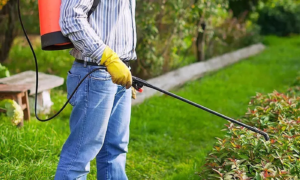Clutter provides places for pests to hide, making preventive measures harder to be effective. Ask your pest control professional about reducing clutter in and around your home. Contact Morristown Pest Control now!
Rodents gnaw and damage furnishings, spread bacteria such as hantavirus pulmonary syndrome and leptospirosis and chew electrical wires that can cause fires. Ask your pest control professional about rodent control methods and products including baits and crack and crevice treatments.

The first step in pest control is proper identification. This includes knowing the pest you’re dealing with, as well as learning about its life cycle, needs and dislikes. In addition, accurate pest identification helps to target control measures with more specificity.
Many non-living organisms may cause damage that’s mistaken for pest activity, making it important to distinguish between living and non-living causes of damage. In particular, plant damage caused by weather extremes, air pollutants, road salt, improper or excessive fertilization and erosion can sometimes be misattributed to pests (e.g., turkeys and deer).
Pests often gain access to facilities by gaining entrance through the tiniest of openings. During inspections, make note of the entrance points to facilities and repair them with caulk, steel wool, etc. This is especially important for structures that are located in or near water sources, such as lakes, rivers and streams.
Similarly, leaking pipes should be repaired to prevent entry by rodents or insects, and trash cans should be regularly emptied to eliminate attracting food sources. Also, reducing clutter and removing potential hiding places can reduce pest activity.
Once a pest has gained access to your facility, it will need food, shelter and water. Eliminate these by securing dumpsters, properly disposing of waste in sealed containers and reducing areas where food or water is stored. Regularly checking incoming delivery vehicles parked outside of facilities for signs of rodent infestation, such as gnawed wiring, is another important preventative measure.
For a wide variety of insects, such as mosquitoes, ticks, bees, wasps, ants and cockroaches, it’s possible to identify them using a basic field guide. For some, however, such as spiders and beetles, a physical specimen is required. For this reason, the MMPC’s free Pest ID Center is available to analyze images of these mystery pests and provide identification results. Visit this page to upload pictures or submit a question. MMPC’s Pest ID Center is staffed during normal business hours, 8:30am to 6:30pm weekdays and 10:00am to 6:00pm weekends. All information provided by the Pest ID Center is kept strictly confidential.
Prevention
In pest control, prevention is an important strategy. Preventing a pest infestation is much less costly than attempting to eliminate an established pest population. The goal of preventive pest control is to minimize the chance of an infestation by identifying and eliminating conditions that encourage pest activity. This may include inspecting food shipments and facilities, sealing cracks in walls and other areas, practicing good sanitation practices, and more.
Understanding a pest’s life cycle is helpful in preventive pest control. Knowing the pest’s lifespan and stages helps you determine when it will be most vulnerable to intervention. This allows you to use more targeted interventions and reduce the likelihood of side effects.
Pests are animals, plants or other organisms that infest buildings and/or their environs and cause economic or health damage. They usually include rodents (Black and Brown rats, house mice), crawling insects (cockroaches, ants, termites) or flying insects (flies, bees, wasps, moths, fermentation flies). In the food industry, pests are any animal at any stage of its life that will reasonably cause biological/physical contamination to food or its presence will detract from its wholesomeness.
The earliest form of pest control is physical or mechanical, including traps, screens, barriers, fences, radiation and more. Weather conditions can also affect pest populations directly, affecting their activity or killing them. For example, plant-eating pests are affected by their host plants’ growth, so unusual weather can cause an increase or decrease in their populations.
Chemicals and insecticides can be used in preventive pest control, as well. However, when using chemicals, always read and follow the label’s instructions and warnings. The label will tell you how and where to apply the product, how long it will remain effective, and what precautions you should take.
Other natural methods of preventive pest control include releasing a pest’s enemies, such as predators or parasites, into the environment. This can help control pests in a safe and ecologically responsible manner, although there is usually a lag between the introduction of a new enemy and a corresponding decrease in the pest population. This can be supplemented with sterilisation programmes, which involve the production and release of large numbers of sterile males into an area.
Suppression
Pests contaminate food, cause physical damage to buildings and landscapes, disturb ecosystems and carry disease. They can also cause health problems for people, pets and livestock. Some have a frightening or grotesque appearance, like spiders and silverfish. Others bite or sting, like fleas, bed bugs and mud dauber wasps. Some are a nuisance because of their smell or noise, like mice and rats, cockroaches and ants. Others stain or tarnish things, like carpets, fabrics and wood.
There are three ways to control pests: prevention, suppression and eradication. Prevention involves avoiding them and keeping them from getting near the food, building or environment where they cause harm. Suppression is reducing their numbers to an acceptable level. Eradication means killing them all.
Physical controls, such as traps, barriers and fences, can keep pests from entering buildings or yards. Chemicals can alter the environment to reduce their numbers, including fungicides, herbicides and insecticides.
Some pests are controlled naturally by parasites, predators and pathogens that kill or reduce their populations. Plant-eating pests are often killed or suppressed by weather conditions, such as frost, drought and floods. The population of some insect-like organisms is dependent on the number of their host plants, and their numbers are affected by changes in the number or size of those plants.
In some cases, natural enemies of a pest, such as birds, reptiles, amphibians and fish, can help control its numbers. In other cases, the presence of other insects, such as beneficial nematodes, can reduce a pest’s population.
Sometimes a particular species of plant is destroyed by an introduced pest, such as an invasive species of tree or vine. These species can become so abundant that they compete with native plants and destroy their habitats. Other factors that can contribute to the destruction of native species include climatic conditions such as temperature, rainfall, day length and humidity. These conditions can affect a plant’s growth and its ability to resist the invasion of a new species. They can also affect the amount of water a plant needs and its tolerance for stress.
Remediation
Pest control is the practice of eliminating or managing pests, which are organisms that negatively impact humans in a number of ways, including spreading diseases, contaminating food, spoiling property, and disturbing ecological balance. Pests are typically small mammals (such as mice and rats), birds, insects, weeds or plants.
The methods used to control pests vary widely and may include poison baits, trapping, insecticidal sprays, fumigation, or extermination. It is important to note that pesticides are often toxic and must be disposed of carefully. The use of pesticides also carries with it the potential risk of human exposure, which is why many people opt to hire professional pest control services.
A well-established pest management system is essential to maintaining healthy ecosystems in residential and commercial settings. In addition to promoting human health through the prevention of disease, pest control provides a variety of other benefits such as safeguarding agriculture and food supplies, preserving property, and maintaining ecological balance by preventing invasive species from disrupting native populations.
The most effective way to treat pests depends on the type of infestation and its severity. For example, rodents and other vertebrates can be effectively controlled with traps and rat baits. Insects, on the other hand, are usually controlled using granules, gels, or sprays that target specific types of insects.
Some pests, such as cockroaches and termites, are difficult to eliminate with traditional pest control methods. These pests require a more comprehensive approach that includes a combination of baiting, trapping and other forms of treatment. This is why most pest control providers use multiple techniques to eradicate a single infestation.
Integrated pest management aims to reduce the use of chemical controls in order to maintain environmental quality. This strategy involves evaluating crop tolerance to pest damage and understanding interactions between crops, natural enemies, and landscapes. It also involves determining the appropriate frequency of pesticide treatments, based on the principle that crops can often tolerate significant levels of insect damage before yields are seriously affected. In addition, biological controls are now being implemented on a large scale to replace conventional pesticides in some situations.



